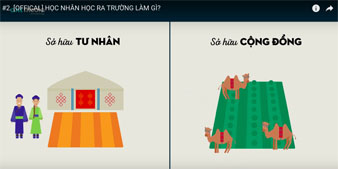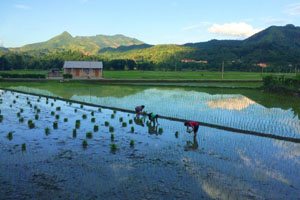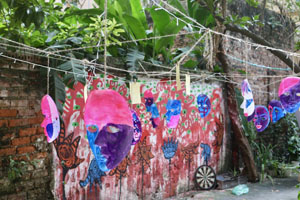A remarkable public media project showcasing the work of young anthropologists in contemporary Vietnam has just celebrated its second anniversary of full-scale operation. The project, entitled ‘Anthropology for today's Vietnam: An online public communication initiative,’ is the brainchild of our former PhD student Dr. Lam Minh Chau, now Senior Lecturer and Deputy Head of the Department of Anthropology, University of Social Sciences and Humanities, Hanoi (USSH), in close collaboration with his departmental colleagues and students.
The project’s goal is to introduce the aims and concerns of anthropology to a very wide public audience in Vietnam, a country where anthropology has been a very fast-growing field of research and study in the last two decades, but where hitherto understanding of why and how anthropologists do their work, the unique skills they have, and how anthropological knowledge can be applied in practice, has been fairly limited.
Launched in November 2017 with a grant from our departmentally administered Evans Fund, which supports research in anthropology and archaeology in South East Asia, the project makes innovative use of online media resources to communicate to the wider Vietnamese public something thus far lacking in today's Vietnam: an understanding of anthropology's aims and concerns, particularly the importance of our core methods of intensive on-site ethnographic fieldwork. What the organisers hoped for was that the project’s mix of student-made ethnographic films and lively 'what is anthropology?' tuition clips would dramatise for people throughout Vietnam the exciting things our field can to do to shed critical light on the many
complex changes with which the country and the world more broadly are currently grappling.
The project’s first year of operation saw the birth of a series of ethnographic films made as YOUTUBE items by students from the USSH Department of Anthropology. Among them was a 15-minute film by a group of six students, led by two undergraduates named Ngoc Binh and Ha Trang, on a distinctive and colourful aspect of ethnic minority life in Vietnam: the beauty and richness of the material culture of one of the country's many highland peoples, the Nung of the far North East. The film makers focused on the production by Nung villagers of the vivid red votive papers displayed on the walls and doors of their village houses as auspicious emblems to welcome in the New Year. The students who made the film focused on ensuring that it was the voices of the local people that carried the story, with particular emphasis on how Nung villagers themselves thought and spoke about their ritual world, so there was no danger that their interlocutors would come across as people being spoken of rather than speaking in their own terms about the objects they made and valued.
This series of ethnographic films is supplemented by two special animated videos, produced entirely by the students themselves, on major questions frequently asked by the Vietnamese public about our discipline: what anthropology is, what kinds of work anthropologists can do, and how anthropological knowledge can be applied in practice. ‘Instead of using plain narration, texts and still images, the videos feature plenty of audio and visual effects to make them more engaging and easy to understand for the audience, notably animations, action graphics and the other kinds of tools and effects young Vietnamese are familiar with and find compelling in online media,’ said Tai Linh, who leads the animated video group.
He was showcasing a section of one of the videos, in which the team seeks to illustrate one of the classic issues in Social Anthropology: the ‘tragedy of the commons’ thesis and its relevance to debates about the privatisation of land and livestock holdings in pastoral societies such as Mongolia. In the video, cheerful informal animations and action graphics are used as tools to convey ideas that would otherwise seem remote and abstract to a general audience unfamiliar with anthropological terms and concepts. What the animations show are two contrasting scenes, one in which livestock is confined to individual households’ holdings and thus is unable to survive then the land is grazed to the point of depletion, and the other in which the animals are free to roam across collectively managed grounds where access to the best grazing areas is available to all. ‘As a first-year student, I have been baffled with explanations of anthropology on jargon-laden textbooks. Luckily, I find these videos, which explain what anthropology is in ways much easier to understand,’ said an anthropology student after watching the videos on the YOUTUBE site.

Screenshot from one of the animated ‘What is anthropology?’ clips. To the left is the scene of over-grazed lands of individual household under the effect of land privatisation, and to the right is the scene of animals roaming freely on collectively managed grounds to access the best grazing areas.
Building on the momentum of the first year, the second year of the project saw the emergence of two new priorities. One has been the diversification of communication platforms. ‘While the Youtube site is clearly a refreshing means of communicating anthropology to the public, there is a strong consensus amongst project members about the need for additional channels of communication, particularly ones that can foster two-way interactions between the project team and the public audience with whom it seeks to dialogue,’ explains Lam Minh Chau.
This aim inspires the establishment of two mass media platforms, one is the official website of the project, http://nhanhoc.vn, and the other is a facebook page, https://www.facebook.com/nhanhocvn/. These two platforms not only work as a site to publish and disseminate the films and videos produced, but also a place of social networking, where the project team now interact with their audience on a daily and real-time basis, collecting their feedback and suggestions so as to adjust and improve the contents and audio-visual effects of the videos.
The birth of the website and the facebook page also lays the foundation for the achievement of the project’s second new priority: the diversification of communication contents. While keeping an energetic eye on the production of new films and videos, the project has been able to communicate anthropology to the public through a much wider range of media products now available on the website and simultaneously advertised on the facebook channel: student’s diaries from the field, reviews of prominent anthropological works, essays and discussions by students on anthropological issues, and updates on efforts and initiatives of anthropologists worldwide. ‘The website and facebook page are indeed inspired by, and have enormously benefited from, the online Encyclopedia of Anthropology initiative of the Department of Social Anthropology, the University of Cambridge. By launching these two platforms, we hope to create an ‘eco-system’ where anthropological knowledge is presented, discussed and shared in a variety of channels and forms, in ways broadly accessible not only to anthropology students but also the general public,’ said Lam Minh Chau.

Photo from one of students’ ‘diaries from the field’ entries on the Project website.
The latest of the project’s focuses, which marks the beginning of its third year of operation, is the birth of the Anthropology Reporter column on the project’s website. An initiative by Tran Thi Tung Lam, a third-year anthropology undergraduate, the Anthropology Reporter aims to produce a series of articles in the form of news coverage, focusing on events, places and personal stories of the kinds that have inspired remarkable anthropological interests in the contemporary world. Topics covered so far include queer culture, LGBT lives and identity, mediumship, and photovoice as a technique of ethnographic communication. ‘What we try to do is not simply a matter of news reporting, but also to add to those reports an anthropological substance, in the forms of comments, personal impressions, and experiences from actual participation,’ said Tung Lam.

Photo from a recently published entries on the Anthropology Reporter column
‘This is very much an initiative in progress, and we indeed still have a lot to strive for. Yet it is definitely our hope that this project will become a long-running effort to foster public understanding of anthropology in today’s Vietnam,’ said Lam Minh Chau as he shares with us their vision for the project’s future progress: to use this initiative to create a ripple effect, not only disseminating anthropological knowledge and understanding, but also inspiring a network of similar communication initiatives amongst students and young anthropologists in the country, who are energetically seeking to demonstrate to the public what it is that anthropology entails in today's Vietnam, and why our field has so much to offer in terms of both knowledge and practical solutions to the many problems facing the country and human communities across the globe.
